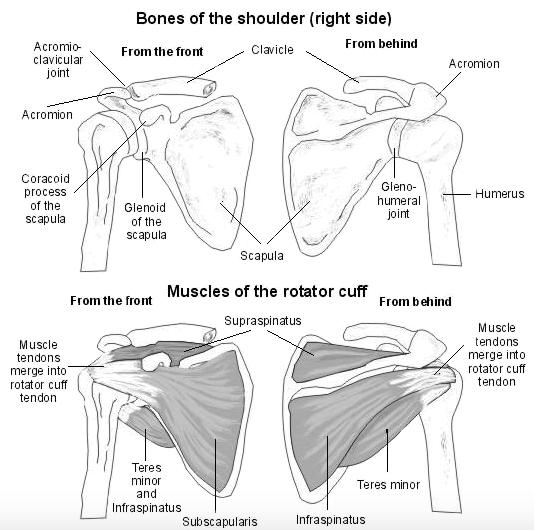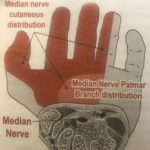
Supraspinatus tendinopathy is a very painful condition usually caused by overuse or traumatic injury to the supraspinatus tendon. The supraspinatus muscle is one of the rotator cuff muscles and, as such, plays an important role in stabilizing the ball-in-socket joint of the shoulder.
Supraspinatus injuries are very common.
What causes supraspinatus tendinopathy?
As with all tendinopathies, supraspinatus tendinopathy is a result of tendon overuse. As is the case with biceps tendinopathy, it is repetitive overhead activities that place the most strain on the tendon.
The supraspinatus tendon is especially stressed when overhead activities are combined with internal rotation. Throwing and front crawl are therefore two activities that you may find difficult if you have been diagnosed with supraspinatus tendinopathy.
Because supraspinatus is such a flimsy muscle, it is also easily injured during trauma, such as a fall on the outstretched hand (FOOSH) or direct trauma, e.g. a shoulder tackle.
What are the symptoms?
Most people have a gradual onset of dull, achy shoulder pain just below the acromion. The shoulder pain can be sharp on certain movements and is often aggravated by activity. You may find it difficult to put a coat on or to sleep on the affected shoulder.
There is also likely to be tenderness of the supraspinatus tendon, and there will be a painful arc. This means an onset of pain between 60 and 120 degrees of active shoulder abduction.
The shoulder pain is typically alleviated with rest or ice.
How is supraspinatus tendinopathy diagnosed?
Most of the time, the case history combined with palpation, and active and passive range of movement tests reveals the pathology. If not, diagnostic imaging can be useful.
Ultrasound and MRI can detect rotator cuff tears or tendinopathies, while an x-ray can show tendon calcification or arthritic changes.
What is the prognosis?
Supraspinatus tendinopathy responds very well to treatment, especially to osteopathy. It is important, however, that any underlying cause is removed. This could be protracted shoulders that reduce the space through which the tendon passes.
With treatment, symptoms can resolve in 2–6 weeks. It can, however, take longer in older patients who have an increased risk of full rupture of the tendon.
What treatments are there for supraspinatus tendinopathy?
Several treatments can help supraspinatus tendinopathy:
Conventional techniques
If the injury is acute, you should protect and rest the shoulder, i.e. avoid aggravating movements.
Icing, ideally 5 to 15 minutes for the first 48 hours, helps control the inflammation. Ice can also numb pain, so make sure you keep the shoulder rested. You do not want to further irritate the tendon by moving your shoulder because you think the decreased pain is suggesting the shoulder is fine.
If your symptoms are more chronic, you should use heat, not ice.
Exercise
The aim of exercise is to mobilise the shoulder within a non-painful range. I recommend a pendulum exercise that involves circumduction of the shoulder. This requires no effort because gravity does the work, and increases local blood supply which promotes tissue healing.
Then, I recommend opening up the shoulder in order to provide more space in the subacromial space. This can be done by stretching the pectoralis minor muscle or swimming backstroke.
A static stretch should be 3 x 30 seconds – less than this has little effect, more than this does not provide additional benefit.
To strengthen the muscle and the tendon, I recommend a thera-band. Isometric, concentric, and then eccentric exercises should be performed.
Finally, a small, light ball is fantastic for proprioceptive exercises. You can roll a ball up a wall for example.
Massage
Massage can reduce tension and resolve trigger points in associated muscles. It can also increase local blood supply that will promote healing. However, massage should not be too gung-ho.
Acupuncture
An acupuncturist will focus on local shoulder points, and LI15, LI16, SJ14, SI10, LI4 and SJ5.
Electrotherapy
Some patients may get pain relief from TENS machines. And low-intensity ultrasound treatment can increase local blood flow and promote tendon healing.
Surgery
Can osteopathy help supraspinatus tendinopathy?
I have found osteopathy, especially when coupled with specific diagnosis based on AK muscle testing, to be very effective in the treatment of supraspinatus tendinopathy.
Muscle testing allows me to tailor the treatment to the individual. For example, it allows me to ascertain reactive muscle patterns. This is where contraction of one muscle can inhibit another muscle. Inhibiting the hyper-facilitated muscle interrupts this abnormal reflex.
In addition to treating reactive muscle patterns, I treat all other functional muscle weaknesses, peripheral nerves and joint dysfunctions in the shoulder. I also address the spine, where the nerve supply arises.
If you think you may have supraspinatus tendinopathy, please get in touch.
To book an Osteopathy appointment in New Malden or in Marylebone, phone 020 8942 3148 or contact Aston Clinic London.
Aston Clinic London is a third-generation complementary health clinic based in New Malden and serves the local areas of Kingston, Wimbledon, Raynes Park, Surbiton, Chessington, Worcester Park, Sutton and other areas of southwest London and Surrey.
Aston Clinic London also offers Osteopathy and Herbal Medicine in Marylebone, Central London.

